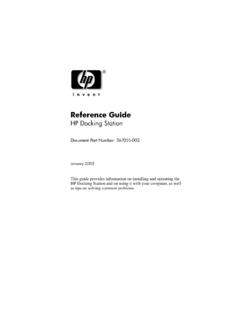Transcription of BIOS-enabled security features in HP business notebooks
1 Technical white paper BIOS-enabled security features in HP business notebooks Table of contents Basics of security protection 2. Protection against unauthorized access 2. Preboot authentication using bios 2. Forgotten passwords 5. Protecting local storage 5. DriveLock hard drive protection 6. Default settings for DriveLock and Automatic DriveLock 6. Automatic DriveLock 6. HP Disk Sanitizer and Secure Erase 6. How does Disk Sanitizer work? 6. How does Secure Erase work? 7. Securing devices 7. Boot options 7. Device control 8. For more information 9. Basics of security protection A computer system is only as secure as its weakest component. Creating a secure system involves looking at all areas of vulnerability and creating solutions to address each of those areas. A typical computer system stores sensitive data on a local hard drive and may have access to network resources containing sensitive information.
2 Therefore, the following areas of vulnerability must be addressed: User authentication Ensuring that an unauthorized person does not access the computer Data on local storage Ensuring that no one can access information simply by removing the hard drive from a secure computer and inserting it into a nonsecure computer or by accessing data after a computer is disposed of Device security Ensuring that the computer does not boot using a device other than the primary hard drive, thereby allowing access to sensitive information by completely bypassing the OS authentication HP has devoted considerable resources to building security capabilities into the bios firmware of HP business notebooks . This document explores the following capabilities: Protection against unauthorized access Preboot authentication Data protection DriveLock, Disk Sanitizer, and Secure Erase technology Device security Boot options and device control HP integrates bios capabilities and the HP ProtectTools software, a rich set of security features that works in Windows to enable enhanced security .
3 This document discusses ProtectTools only as it interacts with the bios security capabilities. For more information about the ProtectTools software, see the HP website. Protection against unauthorized access To help protect the computer from unauthorized access, HP adds preboot authentication to its business notebooks . Preboot authentication is required immediately after turning on the computer and before the OS boots. Preboot authentication also provides protection against attacks that take advantage of the ability to boot from a device other than the primary hard drive. Preboot authentication can be configured by using the bios setup or the ProtectTools software. bios setup A user configures a password for authentication. At power-on, the system prompts the user for the password and allows the boot process to continue if the correct password is entered.
4 If the user configures the preboot authentication password using the bios , the password is independent of the user's Windows logon password and does not allow the One-Step Logon process that is available in ProtectTools. ProtectTools Password authentication or other biometric authentication, such as fingerprint or facial recognition, is configured. This authentication enables the One-Step Logon process for preboot and Windows authentication. If a strong password is chosen, password authentication is an effective way to enhance system security and help protect a system against unauthorized access. To ensure that an authentication password cannot be easily guessed, create passwords by adhering to established security guidelines, not by using personal information. Preboot authentication using bios . On typical computers, the drawback to preboot authentication passwords is that a computer can have only one, so the system is restricted to one user.
5 However, HP has implemented a multiuser architecture in the notebook bios to solve this issue. 2. Multiuser architecture in bios . Multiuser architecture relies on role-based user groups. The bios can separate functions and access among these different user groups. The separation promotes higher security in the following ways: Users no longer need to share passwords. bios administrators do not have to share setup passwords with users. bios administrators can assign granular control of setup features to users. Currently the bios defines two user types. bios Administrator Privileges include management of other bios users, full access to f10 bios settings, and the ability to control f10 access of other users and unlock the system when other bios users fail the preboot authentication. bios User Privileges include the ability to use an authentication password to boot the bios and access f10 bios .
6 Settings as defined by the bios administrator. Enabling bios preboot authentication Before a bios user can be provided with preboot authentication, a bios administrator password must be created. 1. Boot the system, and press f10 to enter the bios setup. 2. Select Setup bios Administrator Password from the security menu. 3. Follow the prompts to create and confirm the new administrator password. The bios administrator sets up the bios user password as follows: 1. Boot the system, and then press f10 to enter the bios setup. 2. Select User Management from the security menu. To add a bios user, select Create new bios User account. 3. Follow the steps on the screen to create the user ID, and then press Enter to continue. By default, the bios user password is the same as the bios user ID. For example, if the bios administrator creates a user1 ID, then the default password is also user1.
7 4. Repeat the steps to create a bios User account for each new user. The bios will now prompt for a bios user password during boot. The bios user can change the default password as follows: 1. Boot the system, and then press f10 to enter the bios setup. 2. Select Change Password from the security menu and follow prompts to change to a new password. NOTE: For maximum system protection, strong bios administrator and bios user passwords must be selected, and the bios administrator password must be different from the user password. If an incorrect password is entered three times, the system prevents any further retries until the system is powered down and restarted. This feature further protects the system from unauthorized access by forcing the user to enter the password manually, thereby preventing dictionary attacks. Users can set up HP SpareKey to regain access if credentials are lost or forgotten.
8 HP SpareKey allows users to answer a series of questions (established during the HP SpareKey enrollment process) to access their notebooks . See the Forgotten passwords section for more information about HP. SpareKey. Preboot authentication using ProtectTools Another way to enable bios preboot authentication is to use ProtectTools security Manager within Windows. The ProtectTools security Manager wizard enables various security levels to protect the computer system and the data. ProtectTools users can set the following security levels: Preboot security Protects the system before it boots to the OS. This ProtectTools function initiates the bios preboot authentication process. HP Drive Encryption Protects computer data by encrypting the hard drive. 3. HP Credential Manager Protects the Windows account. The ProtectTools user can select security levels, as well as the type of security authentication required at each security level.
9 Either a Windows password or a fingerprint can be used for authentication. NOTE: Fingerprint authentication can be enabled only through the ProtectTools software. ProtectTools user privileges include the following: Using the Windows password and other security tokens to authenticate and boot the bios . If enabled , the One Step Logon feature lets the user log all the way into Windows using the Windows password or security tokens. Using the Windows password to access f10 bios setup, based on permissions set up by the bios administrator. Enabling bios preboot authentication with ProtectTools A ProtectTools user can boot to Windows and open ProtectTools security Manager in one of the following ways: Select Set up now from the HP ProtectTools gadget, as shown in Figure 1, and then open ProtectTools security Manager. Figure 1: HP ProtectTools gadget Open the Start menu by clicking the Start icon in the lower-left corner of your screen.
10 Select All Programs, select security and Protection, and then open HP ProtectTools security Manager, as shown in Figure 2. Figure 2: Accessing HP ProtectTools from the Start menu Double-click the HP ProtectTools icon in the notification area, at the far right of the taskbar, and then open ProtectTools security Manager. To set up preboot authentication: 1. Follow the prompts in the security Manager setup wizard to set up passwords, HP SpareKey, and biometric authentication such as fingerprint recognition. 2. Enable preboot authentication for the bios . You can also enable Drive Encryption for HP ProtectTools using the same wizard. The bios will now prompt the ProtectTools user for a Windows password or fingerprint during boot. 4. To set up the fingerprint reader, review the ProtectTools user guide at Use HP ProtectTools Administrative Console to modify the logon policy, credential requirements, or other management settings that have been configured in the security Manager setup wizard.


















